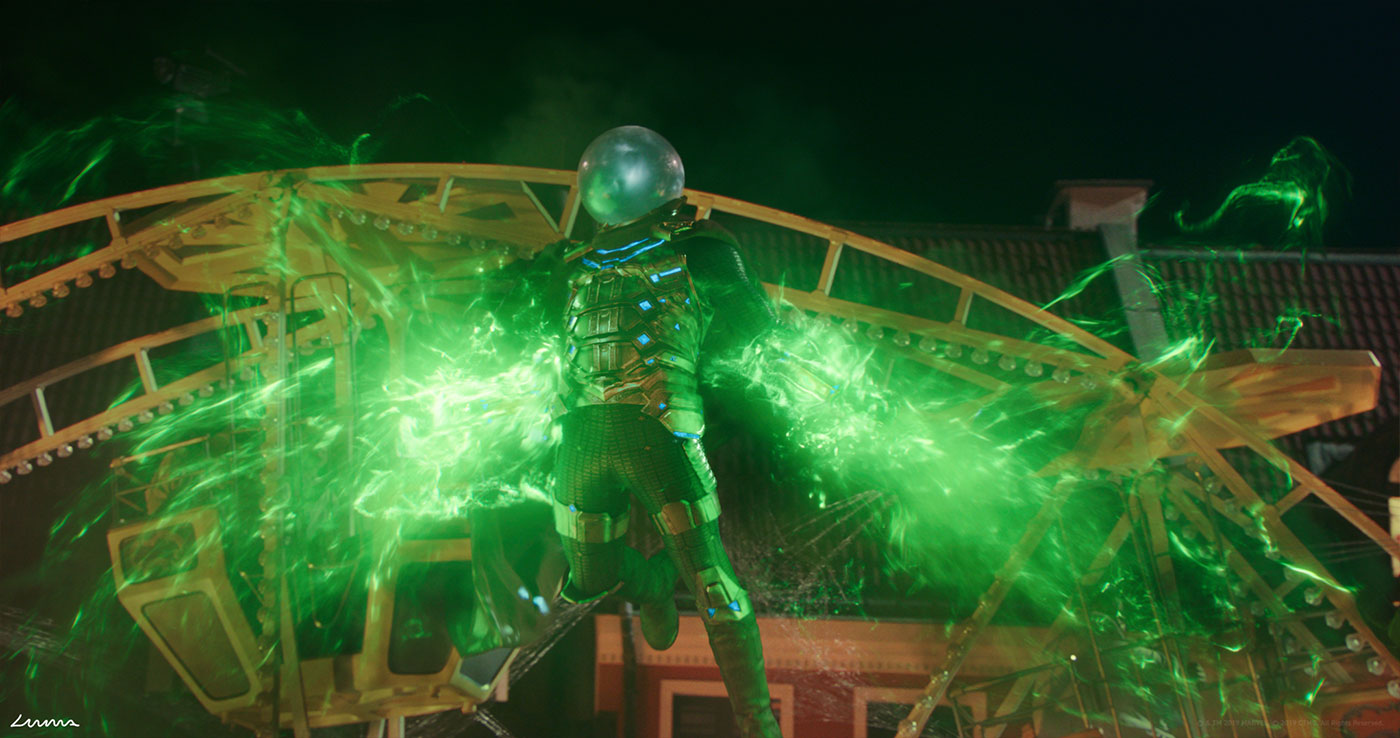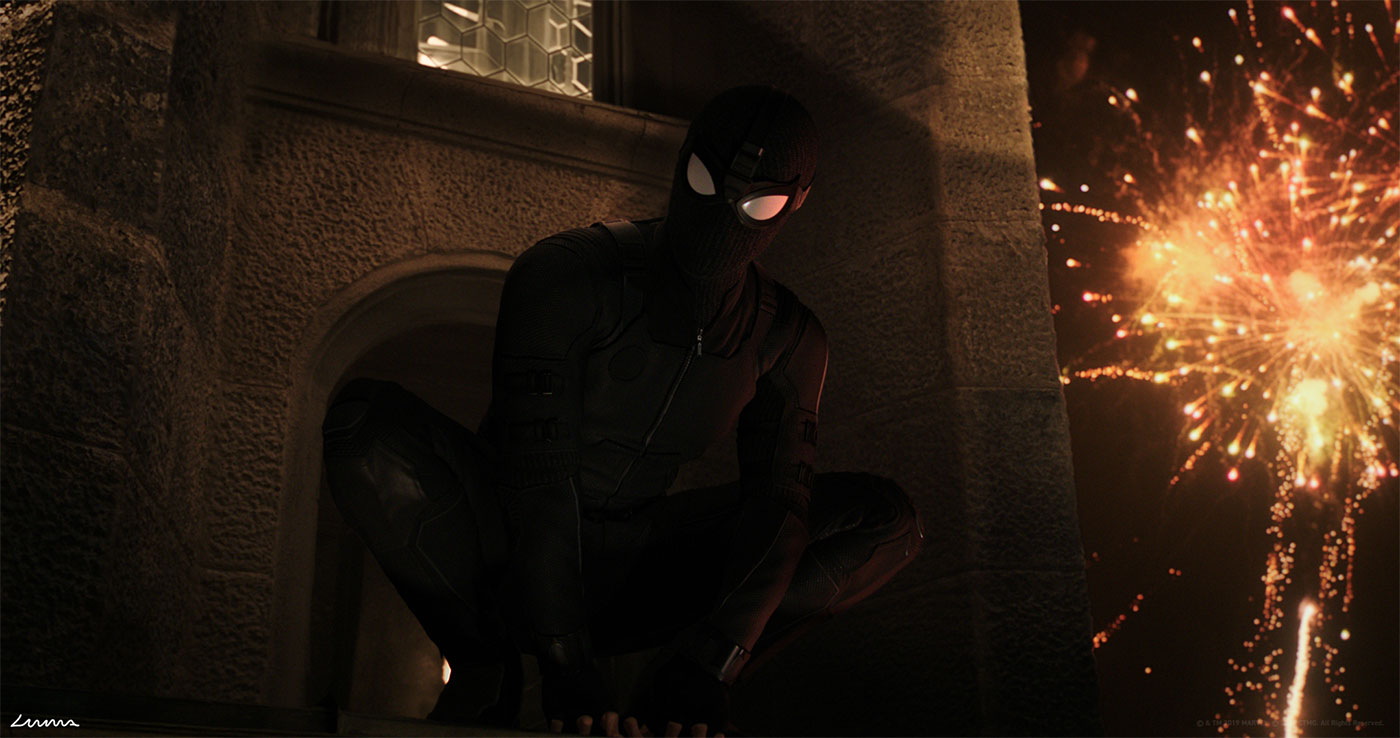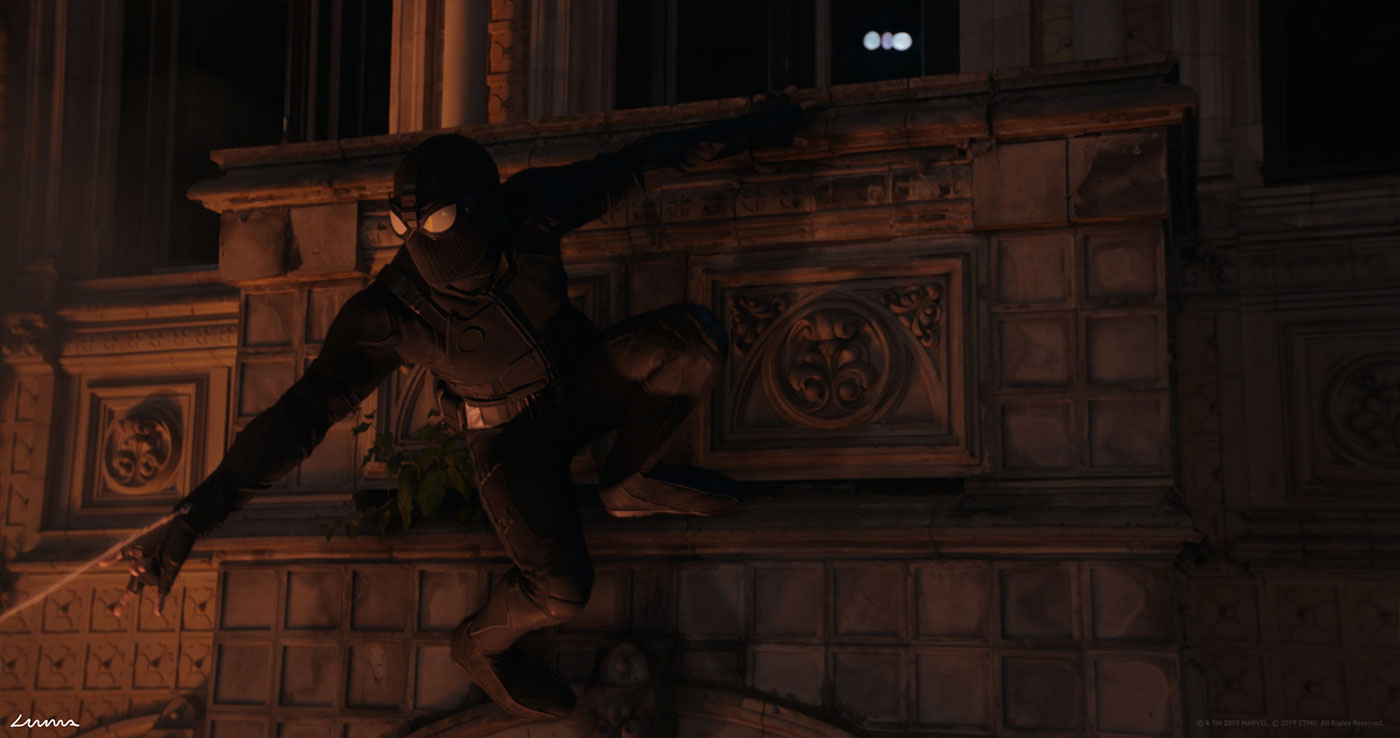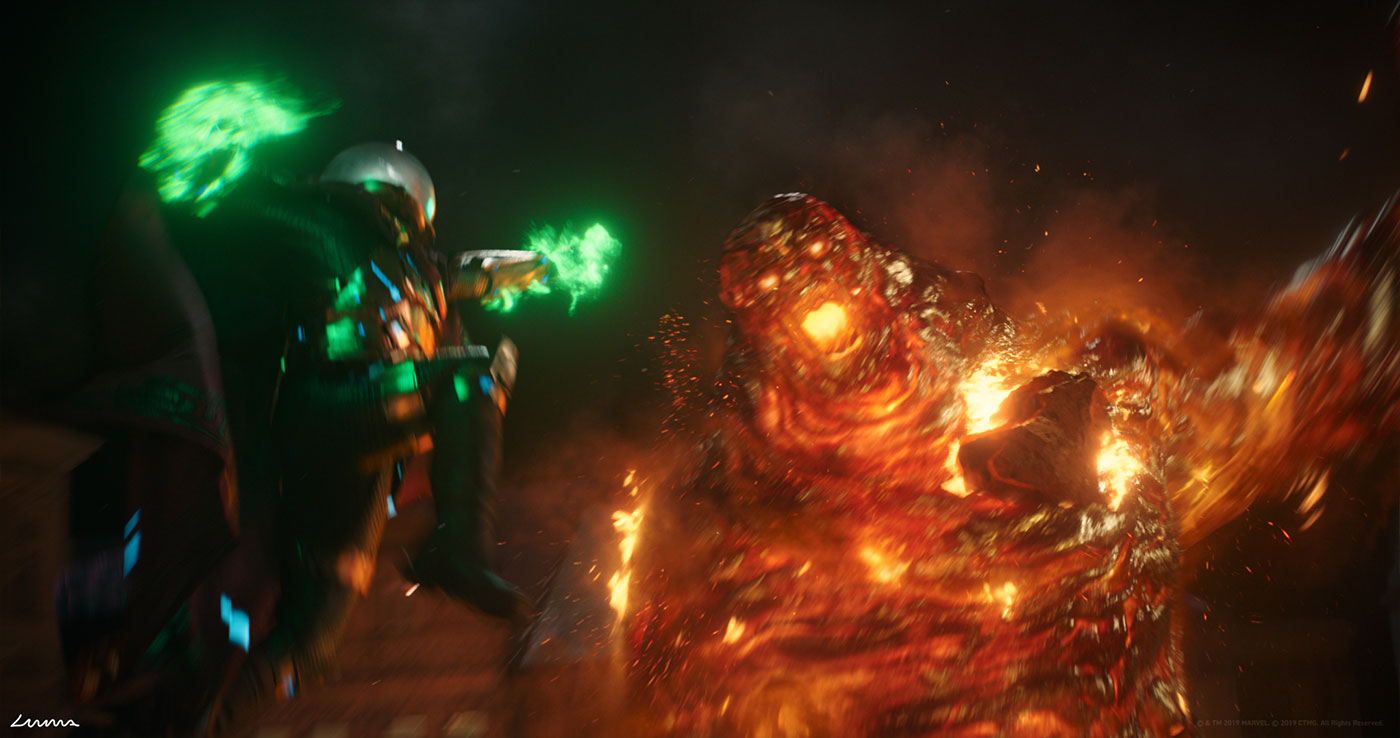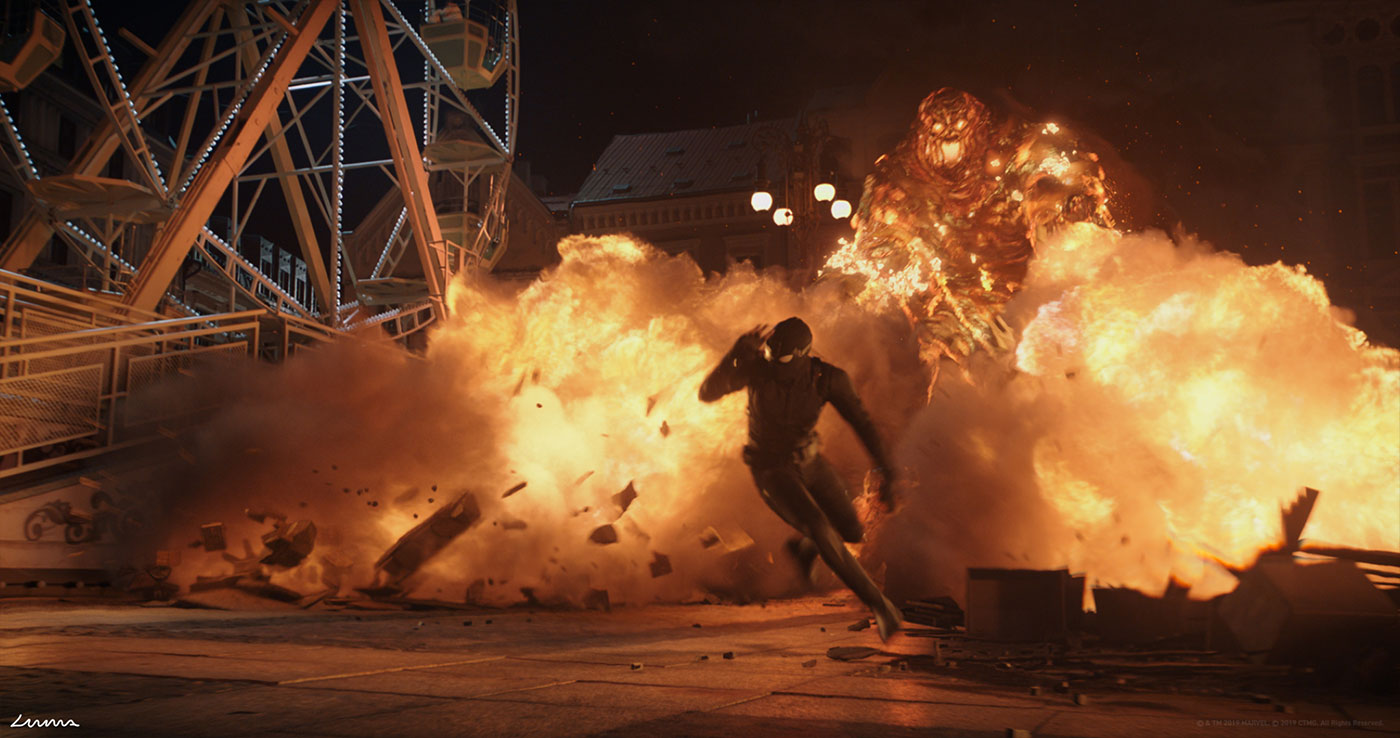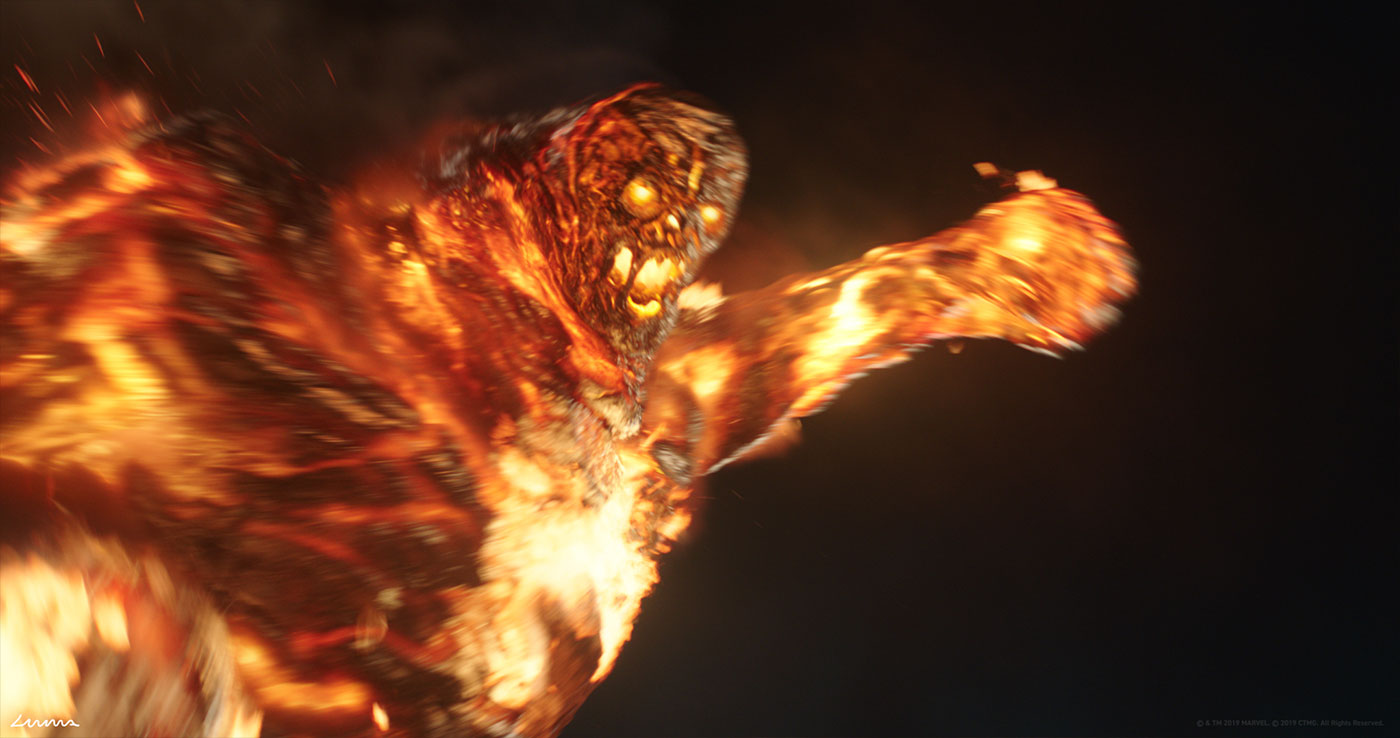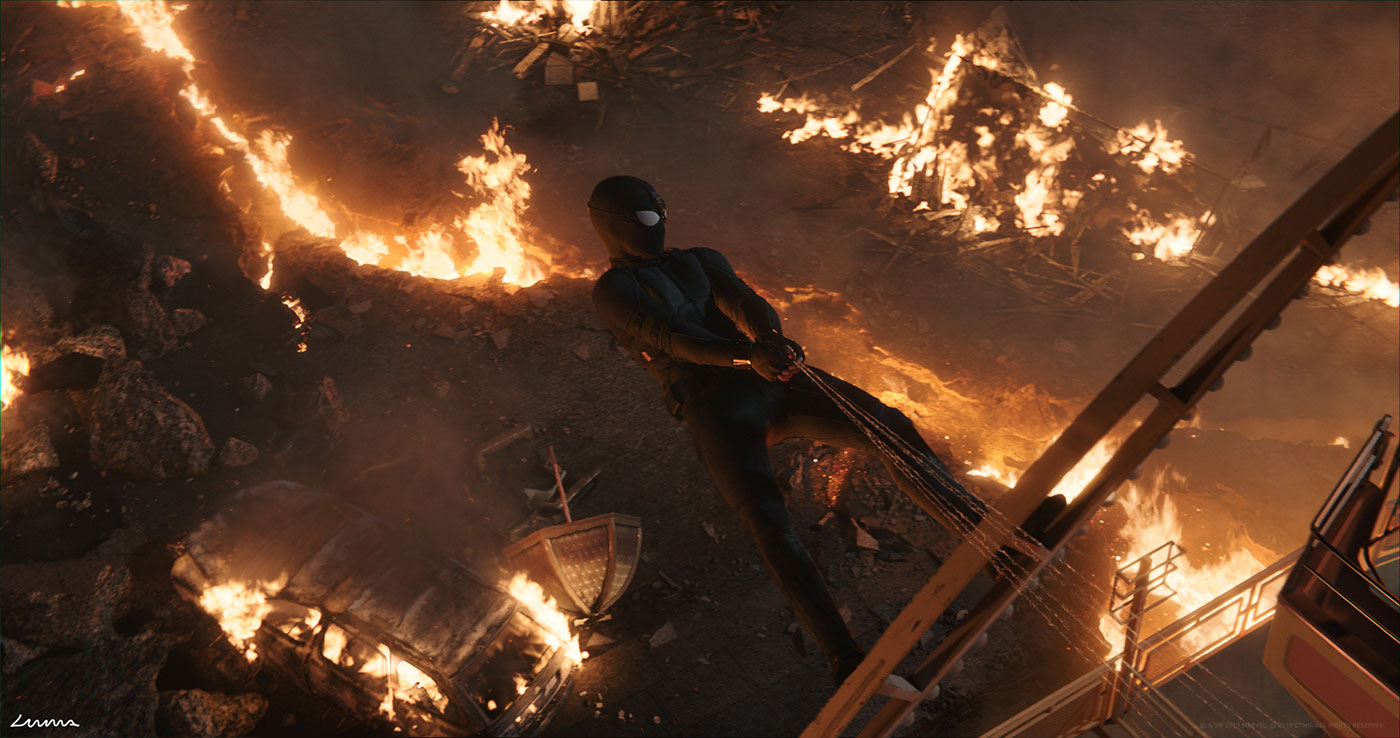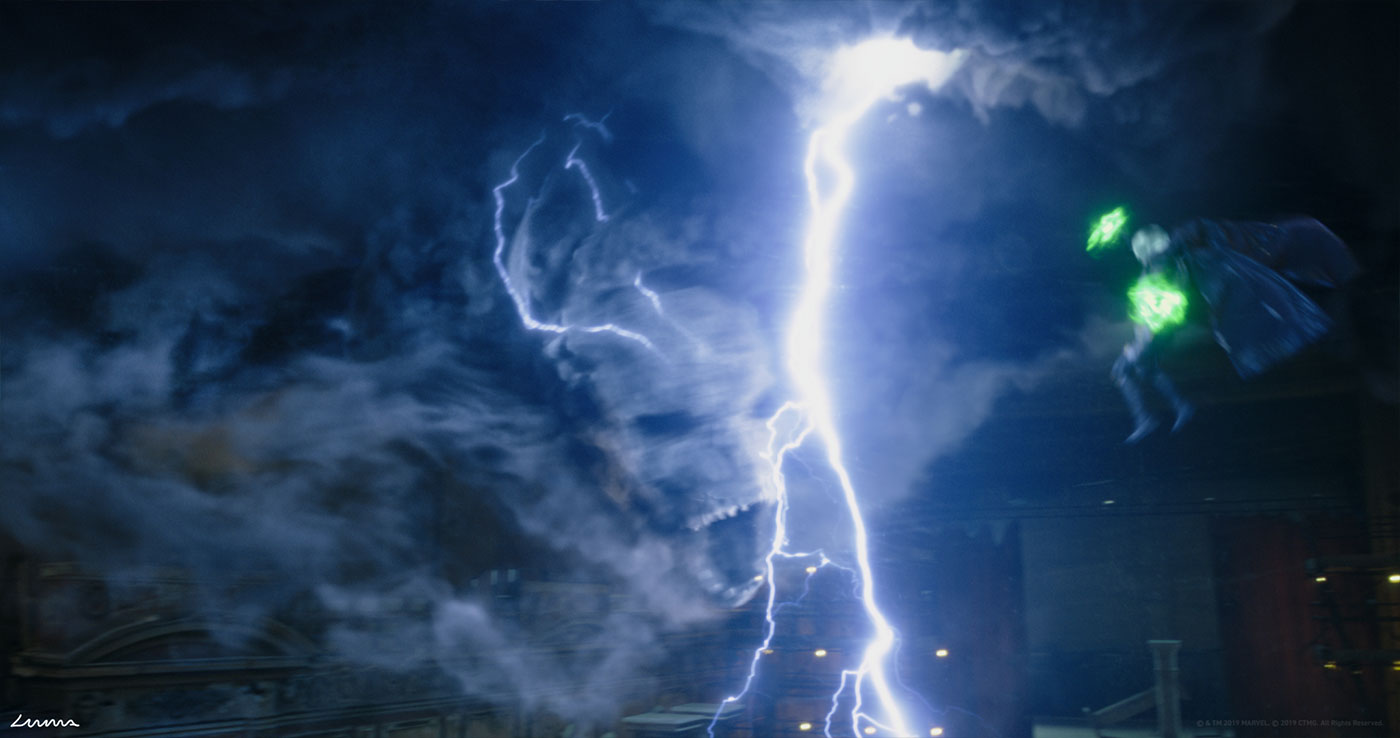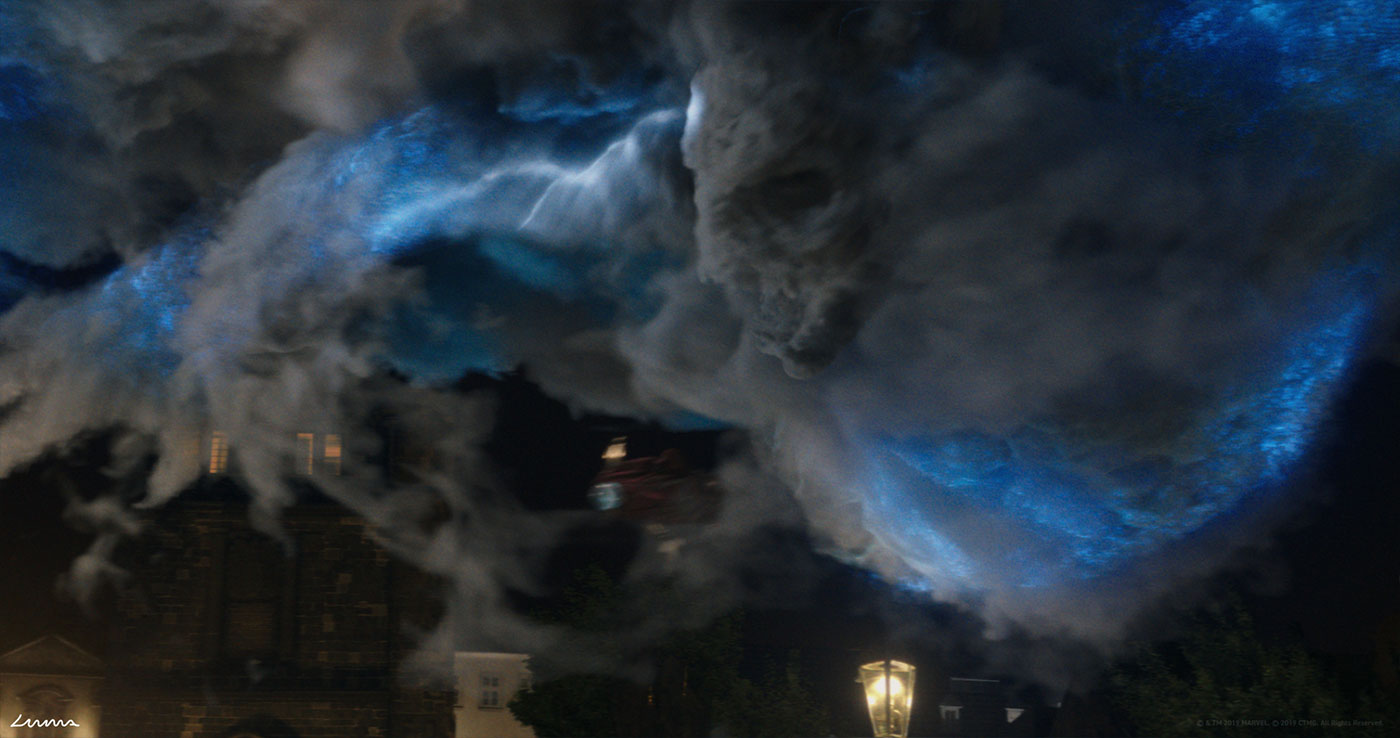Last year, Kevin Souls and Raphael A. Pimentel explained the work of Luma Pictures on ANT-MAN AND THE WASP. They then worked on THE NUTCRACKER AND THE FOUR REALMS, MARY POPPINS RETURNS, CAPTAIN MARVEL and ONCE UPON AT TIME IN HOLLYWOOD. Raphael A. Pimentel also worked on PEPPERMINT and AQUAMAN.
How was this new collaboration with director Jon Watts?
Kevin Souls // As with HOMECOMING, Jon’s primary focus was always story and performance. Our notes cut through the inherent spectacle of the sequences and always went straight to the heart of the shot, the timing and pacing. Did Molten Man feel angry? Do we get a sense of the team up with Spider-Man? Is the reveal of Cyclone, Beck, and the drones clear? Is the BARF technology timed right and in-line with the Marvel canon?
What were the main changes he did about the visual effects since Homecoming?
Kevin Souls // HOMECOMING was a larger shot count overall, with most of our shots focusing on smaller character-driven action scenes. With FAR FROM HOME, the shot count was smaller but with a much higher level of complexity and scale. Rather than the grounded action, we had two massively complex elementals, destruction, and art directed effects.
How did you use your experience from the previous Spider-Man for this new one?
Kevin Souls // We knew where the bar was going to be for quality, and more importantly flexibility. All the work had to look great, but the story would always come first. To that end, we designed all our character and environments look development to prepare for anything.
How did you work with Overall VFX Supervisor Janek Sirrs?
Kevin Souls // It was such a pleasure to work with Janek again on FAR FROM HOME. He is so involved with the overall design and editorial of the show that you’re never without creative direction or feedback. Along with that, he encouraged us to run with character development and take a pass at solutions, allowing us to be part of the creative process.
What are the sequences made by Luma Pictures?
We worked on seven sequences including the big Molten Man Battle, the Bar Chat that happens immediately after, Mysterio’s Lair Rehearsal where the project and drone technology are revealed and the Prague Opera scene.
Can you explain in detail about the creation of Spider-Man black suit?
Kevin Souls // As a featured asset in the Molten Man sequence, the Spider-Man stealth suit was our primary Spider-Man suit for the show. As with most Marvel assets, it had to hold up against a real onset version and also be shared with other vendors.
How did you create the various shaders and textures?
Kevin Souls // We were lucky enough to have reference of the real suit in tons of photography, which had sign off from the studio and the director. A full acquisition was done by Clear Angle, including a high scale scan and hundreds of photographs, including polarized and beauty texture photography. The big challenge was that when creating a black suit, it’s less about the photographic detail and more about the fabric’s textural feel. So we focused on the complex specular response of the weave patterns and fuzz. Luckily, we had tons and tons of real shot reference from which to draw from.
Can you tell us more about his rigging and animation?
Raphael A. Pimentel // His Stealth suit was made from different materials than the other Spidey suits, but it did not hinder Spider-Man from being able to fully flex. His rigging was similar to the other suits— a solid base skeletal rig with automated muscle blend shapes and cloth simulation. This included an additional zipper simulation, which our senior rigger Thanapoom Siripopungul was adamant on implementing.
On HOMECOMING, we stayed away from hitting too many clean poses as Peter was still honing in his superhero skills. There were more flails during swings and missteps. In FAR FROM HOME, Spider-Man is an Avenger and is more in control during the battle, so the animators were able to take the animation towards more powerful, iconic poses and cleaner arcs.
What were the main challenges with animating Spider-Man and how did you achieve it?
Raphael A. Pimentel // Our sequences were very dynamic by design, so choreographing a CG camera with the digital actors during a three-way battle can be difficult. Especially when two characters are ripping past camera, which both Spider-Man and Mysterio were. We found a way to balance it all out by simplifying and focusing on a specific beat at a time. In other words, making sure we gave the audience enough frames to register the beat before panning or tilting to the next action. It sounds simple but it can be quite challenging.
Can you explain in detail about the design and creation of Mysterio?
Kevin Souls // Mysterio was a shared asset amongst the vendors and was created by Scanline. We ingested his textures and model and built our own shaders and rigs. The Helmet interior smoke was also shared, but we got to tackle the Mysterio FX used in our sequence— the emblems, beams, force field and death energy.
How did you handle his animation when he is flying and his cape?
Raphael A. Pimentel // For Mysterio’s flight, we started with research and were inspired by his unique silhouettes in Stan Lee and Steve Ditko’s Marvel Comics, especially his upper body, arms, hands and fingers. We did a number of pose and animation tests even prior to starting post-production, so we had a good idea of who he was and how he moved even prior to plates being turned over.
For specifically flight and fight, we choreographed the timing of the Mocap actions based on the previs editorial beats provided by Marvel Studios. For the cape, the material is relatively heavy—a ripped off version from Dr. Strange’s cloak of levitation. Even though Mysterio’s cape does not levitate, it inherited similar attribute settings in Maya cloth with some weight and wind resistance simulation tweaks. The Molten Man battle and Mysterio’s Lair sequences had different cloth settings to account for the different flight speeds: he flies a lot faster when battling Molten Man than he does with Cyclone.
They are fighting a big Molten Man. How did you work with the art department for his design?
For the big Molten Man fight scenes, we really just pushed all the existing design sto 11. The most important aspect was scale, so we added detail both texturally and geometrically. Additionally, we increased the resolution of all the secondary simulations and added additional forces to really push for detail and scale. From an animation perspective, we had to change the way we animated to imply his increase in size and weight: he got slower, harder to move and harder to stop.
Can you tell us more about his rigging and animation?
Raphael A. Pimentel // Molten Man’s rigs were created with an anthropomorphic setup and growth trigger controllers that the animators could dial in during metal consumption beats. If you notice, Molten Man’s left arm is bigger after he consumes the car and then his back becomes much bigger in the end when the scaffolding falls on him. These triggers were first dialled in animation and then handed to the FX department, where they added simulations to these specific areas to enhance the metal consumption look.
The Molten Man is growing during the fight. How does that affect your work?
Raphael A. Pimentel // We essentially had to build 4 Molten Man models and rigs and each one had unique lookdev and fx simulation setups. All of the rigs were created from the same base rig and for that reason, we could import animation from our mocap library seamlessly and swap out rigs while keeping the work we had previously done. This meant we could easily implement changes to a rig without affecting the other phases.
Each “phase” had to have unique lookdev for the fx of Molten Man, so that the fire and smoke would have the correct scale and dynamics.
How did you manage his internal lighting?
Kevin Souls // A big part of the look of the Molten Man is his radiant glow. During production, special lights were used to throw light into the environment, but we needed to find a solution for lighting his secondary elements, smoke and fire, and the CG environments. Internal lighting, or emission, tends to be one of the trickier things to sample in a global illumination renderer like Arnold. Our first step was to art direct the look of the glow in texture and shading. Molten Man is partially reflective gold, so in the bty render, we added a bounce to achieve his self-reflection. The same is true for the dripping lava. These renders are expensive, so we needed to find a balance of quality and light intensity. For the smoke and environment illumination, we converted the character to a mesh light and matched the intensity, which ultimately gave us more control of our sampling setup.
Can you explain in detail about the creation of the city?
Kevin Souls // The principal photography for the sequence took place in a real public square in Liberec, Czechia. Before production, we were able to get full scans of the environment using lidar and extensive texture photography. This gave us a head start in building out the city for the virtual scenes. We didn’t know where the shoot would take us, so we decided on a tiered approach. We knew we would be using/destroying the ground the most, so we approached that as a photoreal asset. We built medium resolution versions of all the buildings for tracking, previz, and the base for a 2.5 D projection setup for the partial virtual set.
Once principle started and we saw how the square would be dressed and lit, we did another round of acquisition to capture all of the props and assets in the square. We knew we wanted to leverage a projection setup for the virtual environment shots, so we also acquired several additional sets of roundshots and texture photography in the lit environment.
As the edit progressed, we uprezed the buildings needed for the projection setup, built out the stalls, merry-go-round, stage, fountain, Ferris wheel, and all the post-destruction props.
During the fight, many destructions happen to the city. How did you create those elements?
Kevin Souls // We knew the basics of what major props would need to get destroyed, and as the edit progressed, we got a sense of what additional areas of the square needed destruction. Our first step was to create the assets. All of the RBD was handled with Houdini, with complex constraint rigs build for the stalls, buildings, and bricks and tiles on the ground. It was important that modeled with thickness and closed surfaces, and in some instances create interior rooms. We modeled all the interior parts for the carousel and added several layers of geo to represent sand, dirt, brick and tiles for the ground, so that as the ground was torn up or collapsing during the hole to hell.
We wanted the explosions and fire to be big and threatening, and we used a combination of Houdini and FumeFX to create flame throwers and enormous fire balls. The RBD would drive the explosion dynamics and the explosions would then be used to drive the secondary effects on Molten Man, pushing back his smoke and fire.
How did you handle the challenge to rig and animate the Cyclone character?
Raphael A. Pimentel // At the beginning of post-production, Cyclone was a bipedal character. Marvel Studios asked Luma to re-designed the creature and how his torso would drop from the clouds above. Although this new design was a lot more dynamic, it made for a tricky rigging setup, since the motion capture data would not necessarily work with the new design.
We decided to create a hybrid rig that would allow for mocap data to be implemented while inverting the cog controller towards the supercell cloud above. Also, knowing that a funnel cloud vortex could not swiftly change directions, we decided to animate Cyclone by going with the flow, literally! The inspiration behind Cyclone’s motion came from the “hurricane symbol” (a top-down view of a spinning center with 2 overlapping C curved tendrils), which allowed for the supercell and centre or the character to spin while the limbs flowed into their attacking motion— never hitting a pose, but always flowing into and out of it.
Can you explain in detail about the creation and animation of the various FX of the Cyclone character?
Kevin Souls // Maintaining the detail and form of the animation for the Cyclone character was paramount to the way we created the FX simulations. We decided early on to pursue a complex system for deforming volumes as a base. Using that system we were able to maintain all the details and deformations of the original sculpt and animation. It also meant that we could very quickly move animation to render for temp screenings. From that deforming geo, we birthed a secondary layer of emissive volumes that were highly detailed and dense, and we then layered those over the deformed geo.
Can you tell us more about the creation and animation of the drones?
Raphael A. Pimentel // Animating drones can be tricky. We began the animation process by scrutinized drones in motion from video references. Animators then match moved drones as tests, in order to understand drift/hover, propeller noise and weight. Once we felt like we had a solid understanding of what makes drones behave the way they do, given all the principles, we began implementing these principles into our shots.
Which sequence or shot was the most challenging?
Raphael A. Pimentel // From an animation supervisor standpoint, given the energetic nature of the sequence, I have to go with the Molten Man Battle. Composing a three-way battle royale between dynamic characters like Mysterio and Spider-Man, while framing an ever-changing creature like Molten Man was a big challenge. I think we were successful in the end.
What is your favourite shot or sequence?
Raphael A. Pimentel // The long Spidey wall run and flip over Molten Man during their battle.
Fun Fact: The blocking of this shot took 11 separate motion capture clips which were stitched together. The stitching was eventually refined and taken to live action film quality.
What is your best memory on this show?
Kevin Souls // Being at the shoot in Liberec for the Molten Man battle at 4 am and watching the first really big pyro explosion. The police car that Molten Man was meant to absorb was rigged to explode. The pyro guys put a tape line down for a safe distance and we all stood behind. On action, the car exploded sending fire and sparks towards camera, and us! A huge gust of warm air pushed us back, a fireball came right up to the line on the ground and then receded back. Everyone had gleeful smiles.
How long have you worked on this show?
We worked on the show for a full year from June 2018- June 2019.
What’s the VFX shots count?
Over 330 shots.
What was the size of your team?
We had about 110 artists working across our Melbourne and Los Angeles studios. On top of that, we had about 60 support crew.
What is your next project?
We’re currently working on GODZILLA VS KONG, BIRDS OF PREY and a few other projects we can’t talk about just yet!
A big thanks for your time.
WANT TO KNOW MORE?
Luma Pictures: Official website of Luma Pictures.
© Vincent Frei – The Art of VFX – 2019


